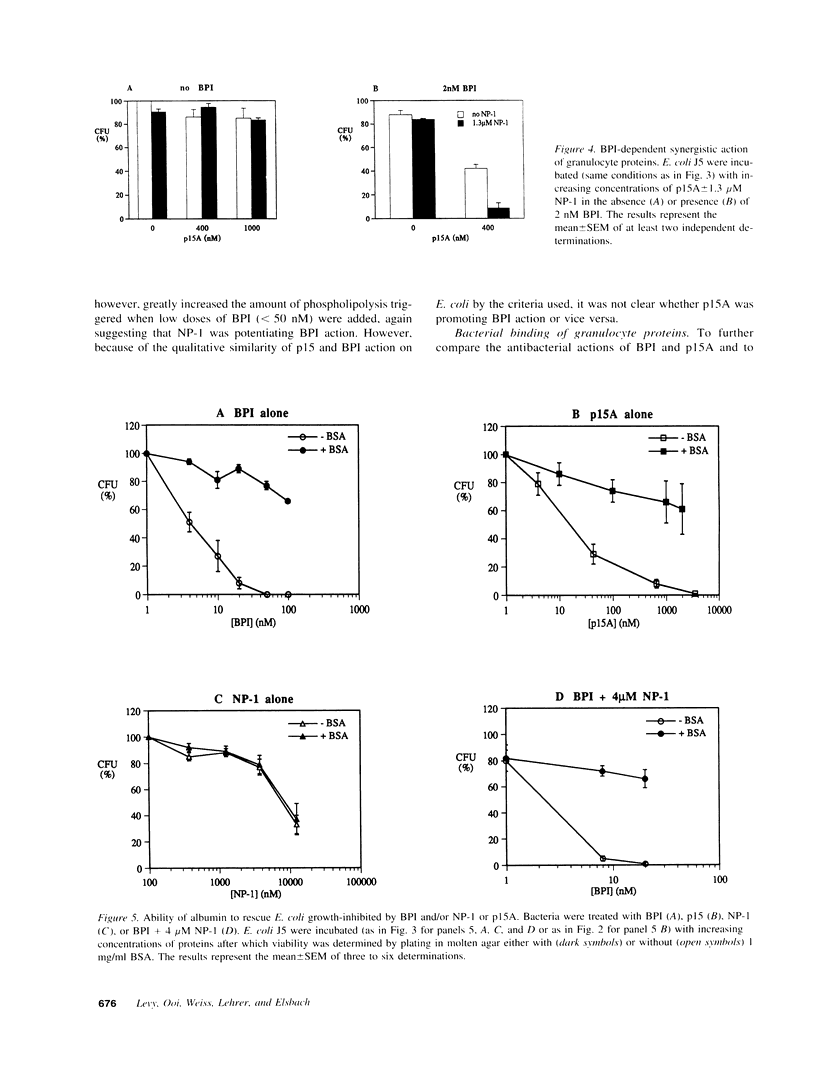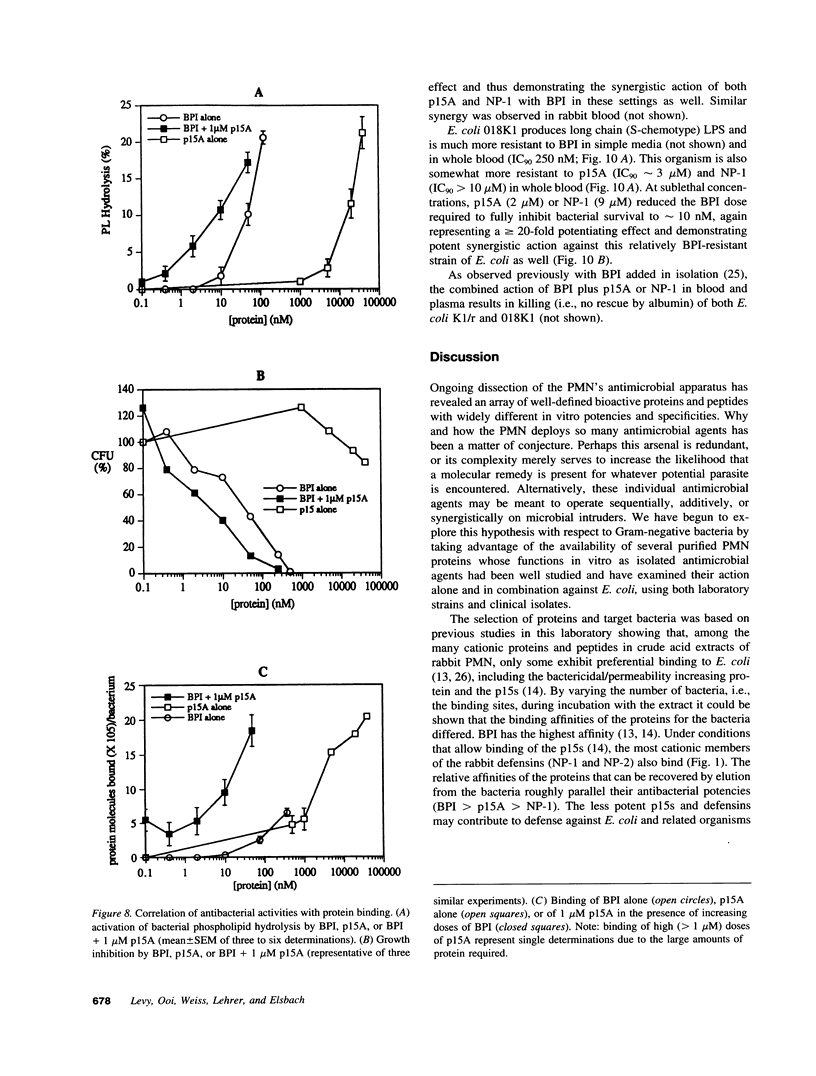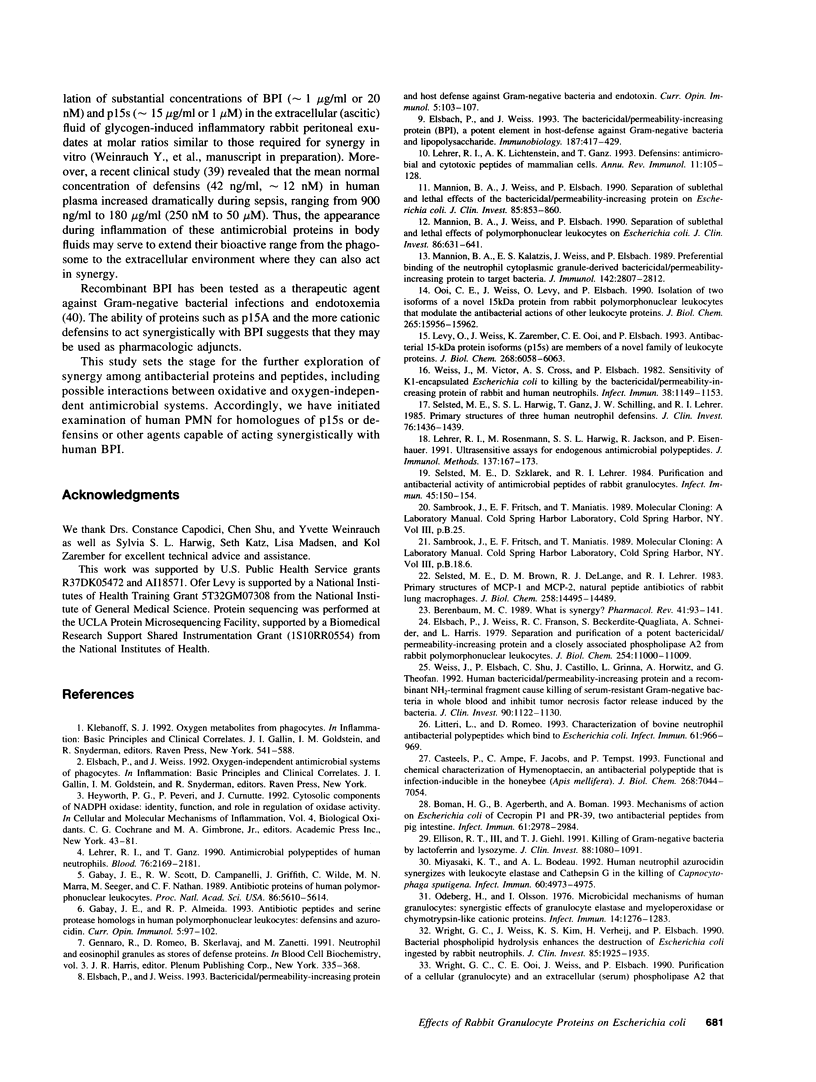Abstract
Affinity purification of crude acid extracts of rabbit polymorphonuclear leukocytes using Escherichia coli (J5) as adsorbent yields the bactericidal/permeability-increasing protein (BPI), two 15-kD species (p15s), and the two most potent (cationic) defensin species (neutrophil peptides [NP] -1 and -2). Tested in buffered isotonic medium, the relative antibacterial potency of these proteins against E. coli J5 is BPI (IC50 0.2 nM) > p15A (10 nM) > NP -1 (400 nM). Sublethal doses of p15A or NP-1 can synergize with BPI to decrease the dose required to inhibit the growth of E. coli by up to 50-fold. BPI and p15A display similar features of antibacterial action distinct from defensin NP-1, but NP-1 acts synergistically only with BPI and not with p15A. All aspects of the combined action of BPI and NP-1 resemble those observed with higher concentrations of BPI alone, implying that NP-1 enhances BPI potency. Neither NP-1 nor p15A alter the amount of BPI binding to E. coli but BPI enhances binding of p15A to E. coli, raising the possibility that synergy between these two proteins may occur at least partially at the level of binding. The potent synergistic actions of these proteins can also be demonstrated against serum-resistant clinical isolates of encapsulated E. coli tested in whole blood and plasma ex vivo, suggesting that such combined action may contribute to host defense in vivo.
Full text
PDF










Images in this article
Selected References
These references are in PubMed. This may not be the complete list of references from this article.
- Berenbaum M. C. What is synergy? Pharmacol Rev. 1989 Jun;41(2):93–141. [PubMed] [Google Scholar]
- Boman H. G., Agerberth B., Boman A. Mechanisms of action on Escherichia coli of cecropin P1 and PR-39, two antibacterial peptides from pig intestine. Infect Immun. 1993 Jul;61(7):2978–2984. doi: 10.1128/iai.61.7.2978-2984.1993. [DOI] [PMC free article] [PubMed] [Google Scholar]
- Casteels P., Ampe C., Jacobs F., Tempst P. Functional and chemical characterization of Hymenoptaecin, an antibacterial polypeptide that is infection-inducible in the honeybee (Apis mellifera). J Biol Chem. 1993 Apr 5;268(10):7044–7054. [PubMed] [Google Scholar]
- Ellison R. T., 3rd, Giehl T. J. Killing of gram-negative bacteria by lactoferrin and lysozyme. J Clin Invest. 1991 Oct;88(4):1080–1091. doi: 10.1172/JCI115407. [DOI] [PMC free article] [PubMed] [Google Scholar]
- Elsbach P., Weiss J. Bactericidal/permeability increasing protein and host defense against gram-negative bacteria and endotoxin. Curr Opin Immunol. 1993 Feb;5(1):103–107. doi: 10.1016/0952-7915(93)90088-a. [DOI] [PubMed] [Google Scholar]
- Elsbach P., Weiss J., Franson R. C., Beckerdite-Quagliata S., Schneider A., Harris L. Separation and purification of a potent bactericidal/permeability-increasing protein and a closely associated phospholipase A2 from rabbit polymorphonuclear leukocytes. Observations on their relationship. J Biol Chem. 1979 Nov 10;254(21):11000–11009. [PubMed] [Google Scholar]
- Elsbach P., Weiss J. The bactericidal/permeability-increasing protein (BPI), a potent element in host-defense against gram-negative bacteria and lipopolysaccharide. Immunobiology. 1993 Apr;187(3-5):417–429. doi: 10.1016/S0171-2985(11)80354-2. [DOI] [PubMed] [Google Scholar]
- Forst S., Weiss J., Maraganore J. M., Heinrikson R. L., Elsbach P. Relation between binding and the action of phospholipases A2 on Escherichia coli exposed to the bactericidal/permeability-increasing protein of neutrophils. Biochim Biophys Acta. 1987 Aug 15;920(3):221–225. doi: 10.1016/0005-2760(87)90098-1. [DOI] [PubMed] [Google Scholar]
- Gabay J. E., Almeida R. P. Antibiotic peptides and serine protease homologs in human polymorphonuclear leukocytes: defensins and azurocidin. Curr Opin Immunol. 1993 Feb;5(1):97–102. doi: 10.1016/0952-7915(93)90087-9. [DOI] [PubMed] [Google Scholar]
- Gabay J. E., Scott R. W., Campanelli D., Griffith J., Wilde C., Marra M. N., Seeger M., Nathan C. F. Antibiotic proteins of human polymorphonuclear leukocytes. Proc Natl Acad Sci U S A. 1989 Jul;86(14):5610–5614. doi: 10.1073/pnas.86.14.5610. [DOI] [PMC free article] [PubMed] [Google Scholar]
- Hoffmann J. A., Hetru C., Reichhart J. M. The humoral antibacterial response of Drosophila. FEBS Lett. 1993 Jun 28;325(1-2):63–66. doi: 10.1016/0014-5793(93)81414-u. [DOI] [PubMed] [Google Scholar]
- Jansen N. J., van Oeveren W., Hoiting B. H., Wildevuur C. R. Activation of plasma systems and blood cells by endotoxin in rabbits. Inflammation. 1991 Apr;15(2):81–90. doi: 10.1007/BF00917503. [DOI] [PubMed] [Google Scholar]
- Kohn F. R., Ammons W. S., Horwitz A., Grinna L., Theofan G., Weickmann J., Kung A. H. Protective effect of a recombinant amino-terminal fragment of bactericidal/permeability-increasing protein in experimental endotoxemia. J Infect Dis. 1993 Nov;168(5):1307–1310. doi: 10.1093/infdis/168.5.1307. [DOI] [PubMed] [Google Scholar]
- Lehrer R. I., Ganz T. Antimicrobial polypeptides of human neutrophils. Blood. 1990 Dec 1;76(11):2169–2181. [PubMed] [Google Scholar]
- Lehrer R. I., Lichtenstein A. K., Ganz T. Defensins: antimicrobial and cytotoxic peptides of mammalian cells. Annu Rev Immunol. 1993;11:105–128. doi: 10.1146/annurev.iy.11.040193.000541. [DOI] [PubMed] [Google Scholar]
- Lehrer R. I., Rosenman M., Harwig S. S., Jackson R., Eisenhauer P. Ultrasensitive assays for endogenous antimicrobial polypeptides. J Immunol Methods. 1991 Mar 21;137(2):167–173. doi: 10.1016/0022-1759(91)90021-7. [DOI] [PubMed] [Google Scholar]
- Levy O., Weiss J., Zarember K., Ooi C. E., Elsbach P. Antibacterial 15-kDa protein isoforms (p15s) are members of a novel family of leukocyte proteins. J Biol Chem. 1993 Mar 15;268(8):6058–6063. [PubMed] [Google Scholar]
- Litteri L., Romeo D. Characterization of bovine neutrophil antibacterial polypeptides which bind to Escherichia coli. Infect Immun. 1993 Mar;61(3):966–969. doi: 10.1128/iai.61.3.966-969.1993. [DOI] [PMC free article] [PubMed] [Google Scholar]
- Mannion B. A., Kalatzis E. S., Weiss J., Elsbach P. Preferential binding of the neutrophil cytoplasmic granule-derived bactericidal/permeability increasing protein to target bacteria. Implications and use as a means of purification. J Immunol. 1989 Apr 15;142(8):2807–2812. [PubMed] [Google Scholar]
- Mannion B. A., Weiss J., Elsbach P. Separation of sublethal and lethal effects of polymorphonuclear leukocytes on Escherichia coli. J Clin Invest. 1990 Aug;86(2):631–641. doi: 10.1172/JCI114755. [DOI] [PMC free article] [PubMed] [Google Scholar]
- Mannion B. A., Weiss J., Elsbach P. Separation of sublethal and lethal effects of the bactericidal/permeability increasing protein on Escherichia coli. J Clin Invest. 1990 Mar;85(3):853–860. doi: 10.1172/JCI114512. [DOI] [PMC free article] [PubMed] [Google Scholar]
- Marra M. N., Wilde C. G., Collins M. S., Snable J. L., Thornton M. B., Scott R. W. The role of bactericidal/permeability-increasing protein as a natural inhibitor of bacterial endotoxin. J Immunol. 1992 Jan 15;148(2):532–537. [PubMed] [Google Scholar]
- Miyasaki K. T., Bodeau A. L. Human neutrophil azurocidin synergizes with leukocyte elastase and cathepsin G in the killing of Capnocytophaga sputigena. Infect Immun. 1992 Nov;60(11):4973–4975. doi: 10.1128/iai.60.11.4973-4975.1992. [DOI] [PMC free article] [PubMed] [Google Scholar]
- Nakamura H., Yoshimura K., McElvaney N. G., Crystal R. G. Neutrophil elastase in respiratory epithelial lining fluid of individuals with cystic fibrosis induces interleukin-8 gene expression in a human bronchial epithelial cell line. J Clin Invest. 1992 May;89(5):1478–1484. doi: 10.1172/JCI115738. [DOI] [PMC free article] [PubMed] [Google Scholar]
- Odeberg H., Olsson I. Microbicidal mechanisms of human granulocytes: synergistic effects of granulocyte elastase and myeloperoxidase or chymotrypsin-like cationic protein. Infect Immun. 1976 Dec;14(6):1276–1283. doi: 10.1128/iai.14.6.1276-1283.1976. [DOI] [PMC free article] [PubMed] [Google Scholar]
- Ooi C. E., Weiss J., Levy O., Elsbach P. Isolation of two isoforms of a novel 15-kDa protein from rabbit polymorphonuclear leukocytes that modulate the antibacterial actions of other leukocyte proteins. J Biol Chem. 1990 Sep 15;265(26):15956–15962. [PubMed] [Google Scholar]
- Panyutich A. V., Panyutich E. A., Krapivin V. A., Baturevich E. A., Ganz T. Plasma defensin concentrations are elevated in patients with septicemia or bacterial meningitis. J Lab Clin Med. 1993 Aug;122(2):202–207. [PubMed] [Google Scholar]
- Selsted M. E., Brown D. M., DeLange R. J., Lehrer R. I. Primary structures of MCP-1 and MCP-2, natural peptide antibiotics of rabbit lung macrophages. J Biol Chem. 1983 Dec 10;258(23):14485–14489. [PubMed] [Google Scholar]
- Selsted M. E., Harwig S. S., Ganz T., Schilling J. W., Lehrer R. I. Primary structures of three human neutrophil defensins. J Clin Invest. 1985 Oct;76(4):1436–1439. doi: 10.1172/JCI112121. [DOI] [PMC free article] [PubMed] [Google Scholar]
- Selsted M. E., Szklarek D., Lehrer R. I. Purification and antibacterial activity of antimicrobial peptides of rabbit granulocytes. Infect Immun. 1984 Jul;45(1):150–154. doi: 10.1128/iai.45.1.150-154.1984. [DOI] [PMC free article] [PubMed] [Google Scholar]
- Weiss J., Elsbach P., Shu C., Castillo J., Grinna L., Horwitz A., Theofan G. Human bactericidal/permeability-increasing protein and a recombinant NH2-terminal fragment cause killing of serum-resistant gram-negative bacteria in whole blood and inhibit tumor necrosis factor release induced by the bacteria. J Clin Invest. 1992 Sep;90(3):1122–1130. doi: 10.1172/JCI115930. [DOI] [PMC free article] [PubMed] [Google Scholar]
- Weiss J., Victor M., Cross A. S., Elsbach P. Sensitivity of K1-encapsulated Escherichia coli to killing by the bactericidal/permeability-increasing protein of rabbit and human neutrophils. Infect Immun. 1982 Dec;38(3):1149–1153. doi: 10.1128/iai.38.3.1149-1153.1982. [DOI] [PMC free article] [PubMed] [Google Scholar]
- Wright G. C., Weiss J., Kim K. S., Verheij H., Elsbach P. Bacterial phospholipid hydrolysis enhances the destruction of Escherichia coli ingested by rabbit neutrophils. Role of cellular and extracellular phospholipases. J Clin Invest. 1990 Jun;85(6):1925–1935. doi: 10.1172/JCI114655. [DOI] [PMC free article] [PubMed] [Google Scholar]
- Wright G. W., Ooi C. E., Weiss J., Elsbach P. Purification of a cellular (granulocyte) and an extracellular (serum) phospholipase A2 that participate in the destruction of Escherichia coli in a rabbit inflammatory exudate. J Biol Chem. 1990 Apr 25;265(12):6675–6681. [PubMed] [Google Scholar]




